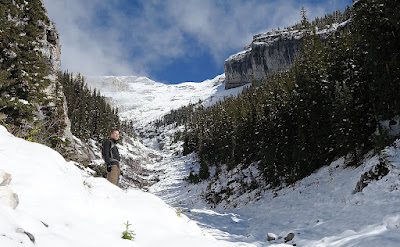This entry was written a few months ago. With the lack of updates recently (due to conditions not condusive to getting out to the mountains), I've decided to post it during this lull. I am hoping to do some backcountry skiing soon, so more entries and photos should come.
I've gotten a lot of comments regarding my weight lately, so I thought I'd do a little write-up of what happened.
On November 26th, 2008, I got back home from having spent a month in Nepal, trekking to Everest Base Camp. A couple of weeks later, I have record of having weighed myself at 163 pounds.
A little less than a year later, while celebrating my birthday with Frank and Tiiu, this photo was taken:
If you look carefully (okay, maybe not that carefully ... it's pretty obvious), you can see a bulge on the side of my gut, hanging over my pants, that was large enough to cast a shadow. It was then that I decided I needed to be a bit more serious about my weight, not just to avoid these sorts of photos in the future, but also to improve my performance in the various hobbies that I enjoy.
So, for the first time in my life, I made what I feel to be a real concerted effort to lose weight. I experimented with many things, some of which worked, some of which didn't, but I did learn a lot about my body and physiology.
One thing I learned very quickly is that each person has their own challenges to overcome when it comes to weight. What works for one person will not necessarily work for another, partly because each person has different bad habits that they need to overcome. The following are the things I learned about myself:
0. Weight loss is not rocket science. (calories in) < (calories out) is the simplest way to think of it. My biggest problem was that I thought I could increase (calories out) enough to lose weight, but what I found was that no matter how much I work out, I can ALWAYS eat more. This was probably the most important realization for me.
1. My main problem food is starch (which contains a significant number of calories). More specifically, rice and pasta. I can eat these two things indefinitely without feeling full, and therein lied my first challenge: to control my consumption of starches. Now, there was no way I could cut them out entirely (this is another thing I learned ... you need to make compromises with your body, otherwise your body will win), but I have managed to reduce their intake, especially in the evenings.
2. Big breakfasts. I now force myself to eat a big breakfast, whether I am hungry or not. After a while, my body adapted and I now get hungry in the mornings (previously, I never had more than a coffee for the first couple of hours of being awake). The main reason this has been important to me is that I find I run out of energy very quickly on my morning runs if I don't eat a large breakfast. If I can't run, then I can't burn calories.
3. Managing my cravings. When I feel like sweets, I have some diet ginger ale. When I feel like salt, I have some pickles. Both have negligeable calories.
4. Keep a record of my progress. The following is a graph of my daily weight:
The line in blue is the actual weight measurements, and the curve in red is the running 7 day average. Perhaps I am results driven, but I like seeing that number go down.
Note that the big dip at the end is because I got sick from food poisoning. I would never recommend that as a way to achieve weight loss, but I have been able to maintain my lower weight without any bad side effects.
5. Don't eat things out of convenience. Fortunately, the list of things I crave which are really bad for me is quite small. However, it is still easy to fall into the trap of eating these bad things because they are typically convenient. e.g. potato chips, instant noodles. Either have healthier options handy or commit to the effort needed to prepare healthier options.
6. Snacks. I think different people differ on what role snacks play in their diets. I realize that an ideal diet involves eating small amounts often. However, I found that this does not work for me, as I have difficulty controlling how much I consume. Sure, having 6 small meals is better than having 3 big meals. But in my case, those 6 small meals would turn into 6 big meals, and that wasn't helping anyone. I have largely eliminated snacks out of my diet altogether, and this has helped me to limit my consumption.
7. Know which battles you can't win. I will allow myself to eat pretty much all the ice cream I can stand. It's just one of those battles that I wasn't going to win, so I focused my energies on battles that were winnable instead. e.g. I generally avoid pastries and baked goods. These were not big deals for me, as I never get cravings for them, but I would eat them if they were available. Now, I don't.
These days, I'm hovering in the 150 to 155 range, which I am quite happy with. My climbing and running have improved drastically, and I'm hoping that ski season shows the same sort of results. I often find myself looking forward to my next meal or going to bed hungry, but the results have been worth it.

















































